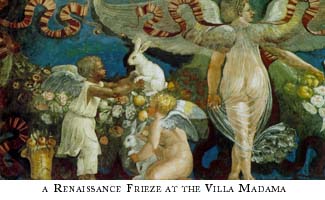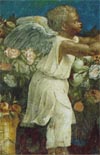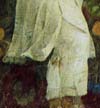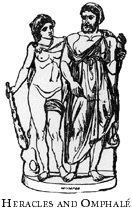


In one of the Medici palaces in Rome - the Villa Madama - there is an image of a cherub in a Renaissance frieze which, considering how it pertains to what we are discussing on this web site, could prove something of a talisman for those of us of mixed racial backgrounds.
Although approximately four foot square, the section with the cherub can easily be overlooked because it's part of a frieze positioned high above the floor and is one in a series of figures - dancing girls, animals, and cherubs - in the garland-festooned mural.The freize is assumed to be the work of either Giulio Romano or his assistant, Giovane da Udine, or both, and to have been painted somewhere between 1521-6.
 With ribbons tying the garlands together around their necks, ten almost provocatively nubile female angels dressed in white classical tunicae serve as anchors. Frolicking in the flower and fruit laden boughs of greenery are four times as many putti or cherubs, two on either side of each angel. What first catches the attention of the observer, however, is that unlike the rest of the putti who are all depicted nude, there is one who is fully dressed. Not only is he wearing a tunic, it is obvious that he is wearing either pants or leggings. Far more arresting than his dress, however, is the fact that this putto happens to be a little black African.
With ribbons tying the garlands together around their necks, ten almost provocatively nubile female angels dressed in white classical tunicae serve as anchors. Frolicking in the flower and fruit laden boughs of greenery are four times as many putti or cherubs, two on either side of each angel. What first catches the attention of the observer, however, is that unlike the rest of the putti who are all depicted nude, there is one who is fully dressed. Not only is he wearing a tunic, it is obvious that he is wearing either pants or leggings. Far more arresting than his dress, however, is the fact that this putto happens to be a little black African.
Besides the rarity of such a black figure, what makes it historically significant is its location. Although named after 'Madama' Margaret of Austria (the illegitimate daughter of the Hapbsburg Emperor Charles V) who owned the villa from 1537 until her death in 1586, this magnificent building was actually built by Cardinal Giulio de Medici who became Pope Clement VII. Giulio de Medici presented the villa to Madama Margarita as part of her marriage to Alessandro de Medici. Although officially passed off as a nephew of Pope Clement VII, Alessandro was in fact the Pope's bastard.
Pope Clement had persuaded Emperor Charles V to make Allesandro the first Duke of Florence and, in obtaining Margarita's hand for him, Pope Clement hoped to insure Imperial protection for his son against factions hostile to the Medici and their autocratic control of the city.
 Although not generally known, it is a well-established fact among scholars that Duke Alessandro was a person of colour. Even the name of his African mother, Simonetta da Collavechio, has been known to researchers for well over a century. Born in 1510, Alessandro de Medici was anywhere between eleven and nineteen when the detail of the frieze discussed here was painted.
The rabbit with which the African cherub or puttino moro is playing is symbolically associated with propagation. This little vignette, therefore, is first and foremost an allusion to Alessandro as his father's only hope for future progeny. But considering who Allesandro was given as his wife, there is the tantalizing possibility that it is also meant to commemorate the marriage of this papal bastard to an imperial one. The significance of what the little black putto is wearing strongly suggests that this could well be the case. Although not generally known, it is a well-established fact among scholars that Duke Alessandro was a person of colour. Even the name of his African mother, Simonetta da Collavechio, has been known to researchers for well over a century. Born in 1510, Alessandro de Medici was anywhere between eleven and nineteen when the detail of the frieze discussed here was painted.
The rabbit with which the African cherub or puttino moro is playing is symbolically associated with propagation. This little vignette, therefore, is first and foremost an allusion to Alessandro as his father's only hope for future progeny. But considering who Allesandro was given as his wife, there is the tantalizing possibility that it is also meant to commemorate the marriage of this papal bastard to an imperial one. The significance of what the little black putto is wearing strongly suggests that this could well be the case.
 For example, there are the pants or leggings showing beneath the hem of the black cherub's costume. Such leggings are seldom seen either in this style or period of painting. In any Latin dictionary, the word for legging, ocrea-ae, immediately precedes that of Ocresia-ae, which--according to the latest Oxford edition--is the name of the slave who was the mother of Servius Tullius, the sixth king of Rome. It could be argued that this similarity of the word ocrea-ae to that of Ocresia-ae is merely coincidental. However, like Servius Tullius, whose given name is a reminder of his "servile" origins, Alessandro was both the son of a slave and a future head of state, as well. It would seem therefore, that the parallel between these two was quite intentional especially since Servius Tullius, according to Roman mythology, had been the most ideal and just of the Roman rulers before the historical age of the Caesars. (Interestingly, despite the difficulty Florentine republicans faced in accepting Alessandro's reinstitution of Medici hegemony, they grudgingly acknowledged his sense of justice and his treatment of the poor and the underprivileged - the same moral values for which Servius had stood) For example, there are the pants or leggings showing beneath the hem of the black cherub's costume. Such leggings are seldom seen either in this style or period of painting. In any Latin dictionary, the word for legging, ocrea-ae, immediately precedes that of Ocresia-ae, which--according to the latest Oxford edition--is the name of the slave who was the mother of Servius Tullius, the sixth king of Rome. It could be argued that this similarity of the word ocrea-ae to that of Ocresia-ae is merely coincidental. However, like Servius Tullius, whose given name is a reminder of his "servile" origins, Alessandro was both the son of a slave and a future head of state, as well. It would seem therefore, that the parallel between these two was quite intentional especially since Servius Tullius, according to Roman mythology, had been the most ideal and just of the Roman rulers before the historical age of the Caesars. (Interestingly, despite the difficulty Florentine republicans faced in accepting Alessandro's reinstitution of Medici hegemony, they grudgingly acknowledged his sense of justice and his treatment of the poor and the underprivileged - the same moral values for which Servius had stood)
However, that reference to Servius Tullius is only viable if this little cherub was painted after the betrothal of the Emperor's daughter to the Pope's son. Any allusion in this mural to Allesandro's symbolic representation as a Roman ruler before this marriage agreement - signed in 1529 - would not have made sense.
As the son-in-law of the Holy Roman Emperor there was a distinct possibility that Alessandro de Medici could indeed ascend to such an august honor. Although the title Holy Roman Emperor was an electoral one (and the candidates, in principle, were any number of European crowned heads) the title in fact had become a Hapbsburg prerogative. Considering the low life expectancy and high child mortality of the period, the fact that Alessandro could, conceivably, succeed one day as ruler of Emperor Charles' Hapbsburg possessions must certainly have played a part in the Pope's proposal to marry his Allesandro to Margaret. On the other hand, the Emperor himself had just been married a few years earlier and the only son he would ever have was still an infant. Thus, it is quite possible that Charles saw in this matrimonial alliance an opportunity for insuring himself a dynasty should his legal heir not survive to do so. What would further tighten this allegory so carefully constructed around the word ocrea-ae, is that very similar to this aspiration of the Pope for his son it represents, Servius Tullius had been designated successor to the King of Rome at his own betrothal to the reigning monarch's daughter.
Such visual charades and puns as in this interpretation of the little black putto's leggings were fairly popular during the Renaissance. We need look no further than the popular Medici "impressa" of the falcon holding a diamond ring in one of its talons as an example of how they might be put together just on the phonetic similarity of the words chosen . The motto for this particular emblem of a Falcon e diamante was Fa con Dio Amante which, translated from the Italian reads, Do all for the love of God.
So, if this play between the leggings of the cherub and Servius Tullius is acceptable, the rest of the symbolism regarding the African putto's costume falls easily into place.
 In contrast to the stark nudity of the other putti, the obvious similarity of the cherub's tunic to that of the female angels, strongly suggests that an inference to cross-dressing is being made. The most famous of the classical stories relating to cross-dressing is, of course, that of Hercules and Omphale. In contrast to the stark nudity of the other putti, the obvious similarity of the cherub's tunic to that of the female angels, strongly suggests that an inference to cross-dressing is being made. The most famous of the classical stories relating to cross-dressing is, of course, that of Hercules and Omphale.
According to the myth, Hercules had been required to serve Queen Omphale in expiation for a murder he had committed. A lonely widow and the powerful ruler of Lydia , Omphale fell in love with him at first sight - and he with her. Far more memorable than any of the adventures Hercules undertook to rid his lover's kingdom of its enemies, are the stories told of how he wore Omphale's clothes and spun wool along with the women of the household. Just as strangely, Omphale went about in his famous lion skin and took to brandishing his massive club.
The implication that Alessandro, like Hercules, was to wrap himself in his wife Maragaret's Hapsburg identity is quite unavoidable since there can be no doubt that to maintain the patronage of his father-in-law, his politics as Duke of Florence would be dictated by Imperial interests.
Likewise, the club and lion skin Omphale appropriates from Hercules in the myth would seem to be a very definite allusion to the Emperor's expectations for his daughter. Having given her to his rather formidable aunt, Margaret of Austria, to be reared and educated, he obviously intended that she would one day play as important a role in the government of the Empire. Not only had Charles named Margaret after his aunt but the position the elder woman held as Regent and Governor General of the Netherlands would eventually become his daughter's. Because this much authority had, until this point in time, been pretty much a male prerogative, both Margarets are today studied since they are among the first women in modern history to have exercised this much political power and influence.
Because it is far more striking than even the little black cherub, what is unmistakably another important clue to this rather intriguing picture puzzle is the fact that one of the female angels has two heads. As utterly bizarre as this figure might initially strike us today, original viewers would have immediately identified it as a reference to the double headed eagle of the Imperial coat of arms. But besides confirming those assumptions regarding the Hapbsburgs already made, there is another phonetic similarity between words being exploited here. Like what was done with the latin word for legging, it is the resemblance of the name, Omphale to that of Omphalos.
According to one of the earliest Greek myths, the center (omphalos) of the earth was determined when two eagles, made to fly in opposite directions, finally met again. Quite obviously this myth is the source for the Hapbsburg arms and, as such, the choice of the character, Omphale (whose name is derived form the same Greek root) to represent the emperor's daughter is a particularly pointed one. And, of course, there's a corollary. Alessandro's African heritage - as represented in the little black cherub - is the same symbolism accorded the sable plumage of the Imperial Eagle.
Because of how many layers of meaning these symbols can have, it is quite possible that even the rabbit which we first dealt with as representative of progeny might have another meaning. The name for Spain is derived from the Berber word, "spania" which means "land of rabbits" and which the North Africans gave to the Iberian peninsula because of how many of these animals they found there. As the grandson of Ferdinand of Aragon and Isabella of Castile and Leon, Charles goes down in history as the first king of a united Spain. Since procreational success was thought to be primarily the responsibility of the woman, it appears that some sort of allusion is being made between the hope for Margaret's fruitfulness and the Spanish identity of the children she would bear Alessandro.
There is one other piece of symbolism in this mural that should be pointed out - the figure of the ostrich painted on the ceiling directly over that of the African cherub or putto. Scholars have observed that the ostrich was used exclusively by Giulio de Medici (Pope Clement). Counter to the tales that it ate iron and all the hyperbole that could be based on that myth, there is a far more sober reading to this emblem. Symbolic dictionaries explain that because it has wings but does not fly, the ostrich is a representation of the hypocrite, especially the kind who preaches an ideal but does not live up to it. What would make it appear that the bird is to be seen as a penitential apologia for the Pope's bastard, Alessandro, is a figure in the mural on the opposite wall. One of the young female angels is decidedly of mixed race. As in the case of the little black putto, the only other ostrich on the ceiling is positioned directly over her figure.
Despite how tightly the pieces of this particular puzzle would seem to fit, there is, of course, another reading, at least with regards to the chronology of how it was painted. Quite possibly, like his playmates, the black putto was originally depicted nudo. It was not until after June 29th, 1529 when the Pope Clement VII and Charles V signed the Treaty of Barcelona that the little fellow was dressed in the items of clothing we've looked at here. Simple enough at first glance, they are in fact symbolically packed, not just with the Pope's bald ambition for his son so arcanely or obliquely implied but with the kind of moral imperative he points out to him, as well.
Whether or not the city of Barcelona, itself, is also alluded to in all that has been discussed in the above still has to be determined. But it would be difficult to simply dismiss as mere coincidence, the tradition that it had been "founded by Hercules and built up by the Punic (African) people." Because Barcelona is where the treaty was drawn up, it is even possible that the part-mythic historic account of the origins of this great Spanish metropolis might have been the initial source for the design of this rather remarkable impressa.
Alessandro de Medici and Margaret of Austria produced no offspring together. He was assassinated some three years after their marriage. But his stint as ruler of Florence was enough for his children, although illegitimate like himself, to establish dynasties of their own. Today the most influential of the old Italian noble families descend from him as well as some of the most prestigious continental houses including a number of European crowned heads and, interestingly enough, a branch of the imperial Hapbsburgs, as well.
Hopefully, for the eternal peace of his soul, the injunction by the papal founder of this line of Medicis to his son was in turn followed by Alessandro's own numerous and 'illustrious' descendants. Only the just and moral exercise of the power they would inherit could serve as reparation for the sin of the flesh Pope Clement (Giulio de Medici) had committed while still a seventeen-year-old cardinal.
Mario de Valdes y Cocom Copyright 1998
|